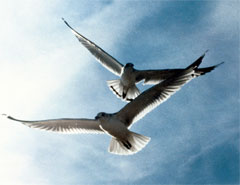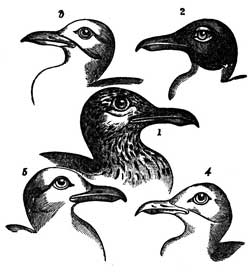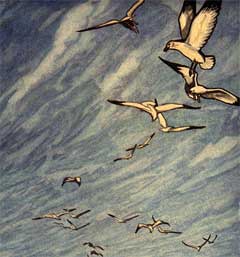
Gulls are, in general, medium to large birds, typically gray or white, often with black markings on the head or wings. They have stout, longish bills and webbed feet.

Seagull Food: Most gulls, particularly Larus species, are ground nesting carnivores, which will take live food or scavenge opportunistically (often leading them to piles of garbage). The live food often includes crabs and small fish.
 Land Lovebirds: Apart from the kittiwakes, gulls are typically coastal or inland species, rarely venturing Land Lovebirds: Apart from the kittiwakes, gulls are typically coastal or inland species, rarely venturing
far out to sea. The large species take up to four years to attain full adult plumage,but two years is typical for small gulls.
Ain't No Bird Brain: Gulls—the larger species in particular
—are resourceful and highly intelligent birds, demonstrating complex methods of communication and a highly-developed social structure. Certain species (e.g. the Herring Gull) have exhibited tool use behavior. Many species of gull have learned to co-exist successfully with man and have thrived in human habitats.

The Common Gull:
The Common Gull, Larus canus is a medium-sized gull which breeds in the northwest of North America (where it is called Mew Gull), Europe and Asia. It migrates further south in winter.
 Classification Confusion: The Common Gull comprises three populations, sometimes considered distinct species: Larus canus canus, the Common Gull, of western Eurasia; L. c. kamschatschensis, the "Kamchatka Gull", of eastern Eurasia; and L. c. brachyrhynchus, the "Short-billed Gull", which breeds in Alaska and western Canada. The European race occurs as a scarce winter visitor to coastal eastern Canada and as a vagrant to the northeastern USA. Classification Confusion: The Common Gull comprises three populations, sometimes considered distinct species: Larus canus canus, the Common Gull, of western Eurasia; L. c. kamschatschensis, the "Kamchatka Gull", of eastern Eurasia; and L. c. brachyrhynchus, the "Short-billed Gull", which breeds in Alaska and western Canada. The European race occurs as a scarce winter visitor to coastal eastern Canada and as a vagrant to the northeastern USA.
To Tree, Or Not To Tree... This species breeds colonially near water or in marshes, making a lined nest on the ground or in a tree.
Just the Facts: At 43cm in length and with a 120cm wingspan, it is considerably smaller than the Herring Gull. Adult Common Gulls are gray above and white below. Their legs are greenish. They have black wing-tips with large white "mirrors", particularly in American birds. Young birds have scaly black-brown upper parts and a neat wing pattern. They take three years to reach maturity. The call is a high-pitched "laughing" cry.
Finders Keepers: These are omnivores like most Larus gulls, and they will scavenge as well as seeking suitable small prey.

What's in a Name? Two terms are in common usage among gull enthusiasts for sub groupings of the gulls:
 Large white-headed gulls: 16 Herring Gull-like species from Great Black-backed Gull to Lesser Black-backed Gull Large white-headed gulls: 16 Herring Gull-like species from Great Black-backed Gull to Lesser Black-backed Gull
White-winged gulls: The two Arctic-breeding species Iceland Gull and Glaucous Gull
Love Has No Boundaries: Hybridization between species of gull occurs quite frequently, although to varying degrees depending on the species involved (see Hybridization in gulls). The taxonomy of the large white-headed gulls is particularly complicated.
Species List:
* American Herring Gull, Larus smithsonianus
* Andean Gull, Larus serranus
* Armenian Gull, Larus armenicus
* Audouin's Gull, Larus audouinii
* Belcher's Gull, Larus belcheri
* Black-billed Gull, Larus bulleri
* Black-headed Gull, Larus ridibundus
* Black-tailed Gull, Larus crassirostris
* Bonaparte's Gull, Larus philadelphia
* Brown-headed Gull, Larus brunnicephalus
* Brown-hooded Gull, Larus maculipennis
* California Gull, Larus californicus
* Caspian Gull, Larus cachinnans
* Common Gull or Mew Gull, Larus canus
* Dolphin Gull, Larus scoresbii
* East Siberian Herring Gull, Larus vegae
* Franklin's Gull, Larus pipixcan
* Glaucous Gull, Larus hyperboreus
* Glaucous-winged Gull, Larus glaucescens
* Great Black-backed Gull, Larus marinus
* Great Black-headed Gull, Larus ichthyaetus
* Grey Gull, Larus modestus
* Grey-headed Gull, Larus cirrocephalus
* Hartlaub's Gull, Larus hartlaubii
* Heermann's Gull, Larus heermanni
* Herring Gull, Larus argentatus
* Heuglin's Gull, Larus heuglini
* Iceland Gull, Larus glaucoides
* Ivory Gull, Pagophila eburnea
* Kelp Gull, Larus dominicanus
* Kittiwake or Black-legged Kittiwake, Rissa tridactyla
* Red-legged Kittiwake, Rissa brevirostris
* Laughing Gull, Larus atricilla
* Lava Gull, Larus fuliginosus
* Lesser Black-backed Gull, Larus fuscus
* Little Gull, Larus minutus
* Mediterranean Gull, Larus melanocephalus
* Olrog's Gull, Larus atlanticus
* Pacific Gull, Larus pacificus
* Red-billed Gull, Larus scopulinus
* Relict Gull, Larus relictus
* Ring-billed Gull, Larus delawarensis
* Ross's Gull, Rhodostethia rosea
* Sabine's Gull, Xema sabini
* Saunders' Gull, Larus saundersi
* Silver Gull, Larus novaehollandiae
* Slaty-backed Gull, Larus schistisagus
* Slender-billed Gull, Larus genei
* Sooty Gull, Larus hemprichii
* Swallow-tailed Gull, Creagrus furcatus
* Thayer's Gull, Larus thayeri
* Western Gull, Larus occidentalis
* White-eyed Gull, Larus leucophthalmus
* Yellow-footed Gull, Larus livens
* Yellow-legged Gull, Larus michahellis

All text is available under the terms
of the GNU Free Documentation License
|